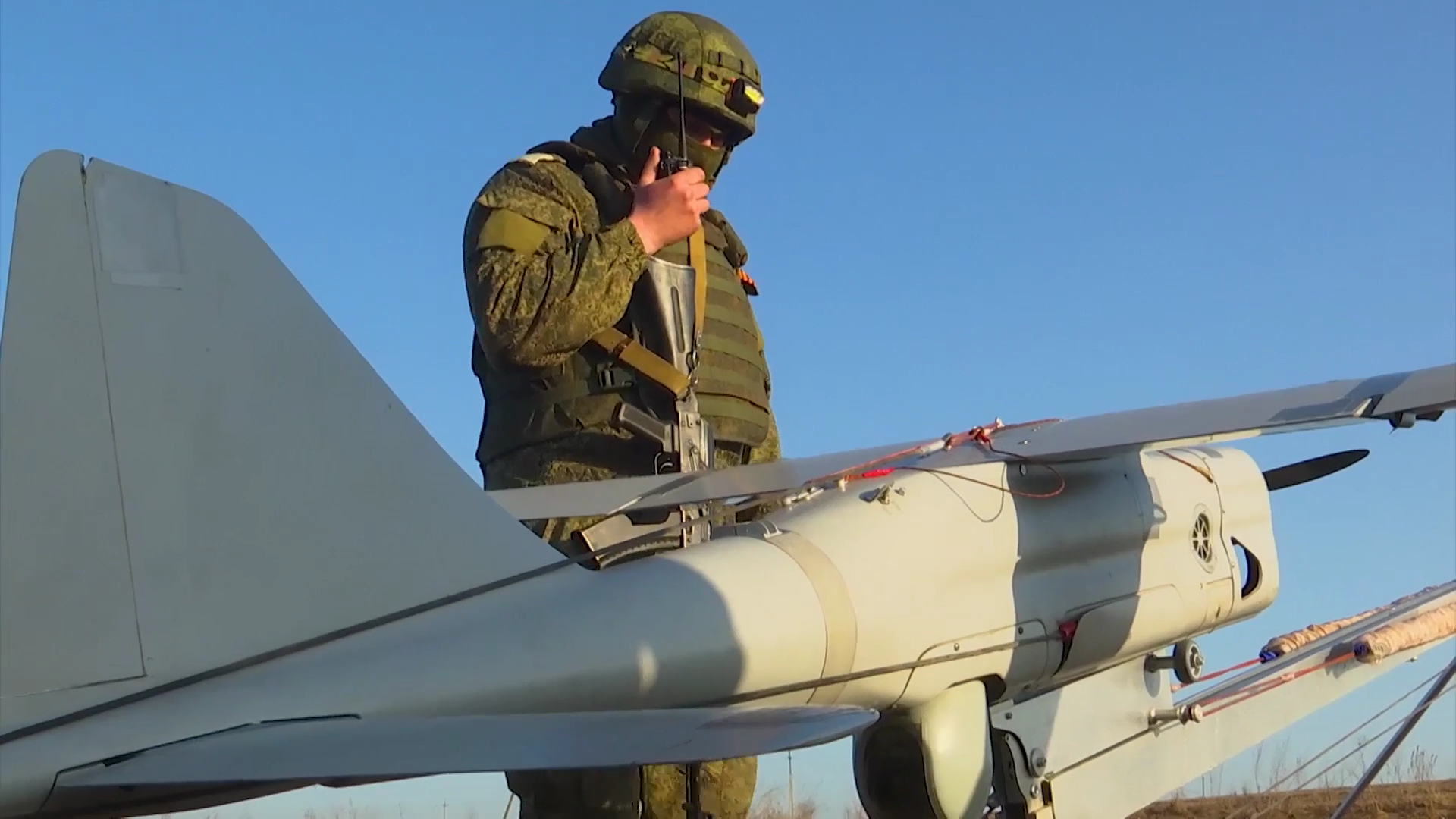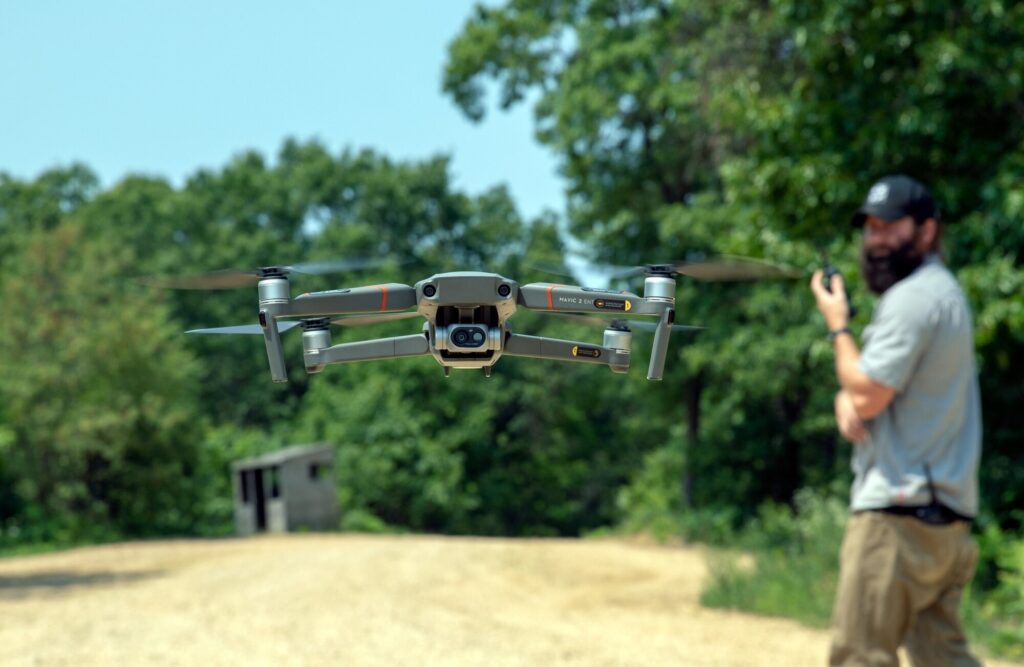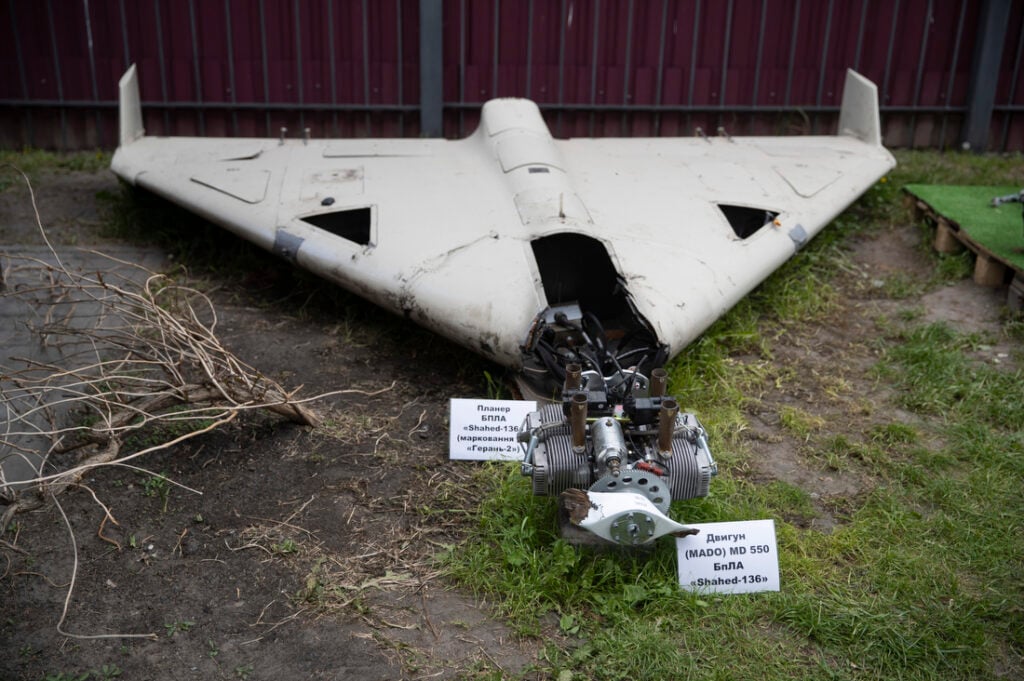SYDNEY J. FREEDBERG JR.

A Russian soldier prepares an Orlan-10 scout drone for flight over Ukraine in 2022 (Russian Ministry of Defense photo via Wikimedia Commons)
WASHINGTON — Drones have proved decisive in fights across Ukraine, with countless videos of destruction flooding social media. Both sides rely on unmanned aircraft, especially cheap off-the-shelf quadcopters, to scout for targets and to strike them — but Russia has had a harder time adapting than Ukraine, according to a recently released report from the Center for Naval Analyses.
The irony is Moscow started out ahead. In 2014, Russian-built drones like the 35-pound, 75-mile-range Orlan-10 pinpointed poorly prepared Ukrainian units for devastating artillery strikes, while Russian jammers blinded Ukrainian communications and reconnaissance. But since then, Ukrainian troops have gotten much better, thanks to a heady brew of Western aid, off-the-shelf technology, and home-grown, bottom-up innovation.
Meanwhile, Russia has struggled to get out of its own way, with grass-roots civilian groups fighting to get imported Chinese quadcopters past the Soviet-style bureaucracy to the troops in the field, while only Iran is willing to sell Moscow military-grade models. Drone warfare has become a microcosm of the military, economic, and cultural differences between the warring sides.
“Three important things happened,” said Samuel Bendett, a CNA Russia expert who co-authored the report, told Breaking Defense in an email:“The absolutely rapid and explosive growth of commercial drone technology makes it cheap, easy and affordable to acquire commercial-type quadcopters and FPV [First-Person View] drones in very large numbers.
“The Russian military’s acquisition cycle and its research and development cycle have not caught up with this commercial technology. Simply put, the Russian MOD [Ministry of Defense] remains a very large, bureaucratic, top-heavy and overburdened apparatus that takes a long while to move in the right direction.
“The unprecedented degree of openness on social media like Telegram has enabled an open and candid discourse on how the Russian military conducted this invasion. The whole story of why volunteer organizations stepped up to assist so quickly, and why the MOD has not officially interfered with them, is something we will be studying for years.”
Now, it’s important not to underestimate Moscow. When Russian units have all the right pieces in place — not just adequate drones, but also trained operators, competent commanders, and a battlefield network to share data — they can still fight with lethal efficiency. A recent report by the UK’s Royal United Services Institute (RUSI) says the time between an Orlan-10 spotting a target and artillery striking it “remains rapid, at around 3-5 minutes.”
But Russia’s fleet of Orlans and other military drones — about 2,000 unmanned aircraft pre-invasion, according to Kremlin claims, one of the largest fleets in the world — has been decimated by 15 months of intense combat. Russia’s domestic drone makers have been slow to replace them, either with more purpose-built military models like the Orlans or with cheaper and less capable civilian-style mini-drones.
That’s in part due to Western sanctions that disrupted imports of crucial electronics that Russia cannot produce itself, in part due to poor coordination among a half-dozen major companies, according to public admissions by Russian experts and officials.
As an example of the problem, Bendett and his CNA co-author Jeffrey Edmonds highlight Almaz-Antey’s heavily hyped Dobrynya, rolled out last fall, with an estimated 1,000 built and sent to the front. Yet the report says even Russian sources acknowledge that the Dobrynya is basically a copy of a Chinese design, and its camera and other key electronics are Chinese imports.
A Chinese-made DJI Mavic drone lifts off to “attack” a convoy during a US Army training exercise in 2021. (Army Photo by Sgt. William A. Parsons)
Indeed, CNA says the most popular mini-drones on either side are the Chinese DJI Mavic series, despite an official Chinese government ban on exporting them to either warring party. Mavics are prized for their ease of use, small size, and cheapness, which makes them almost expendable assets in a conflict where — depending on whether you use Bendett’s estimate or RUSI’s higher one — Ukraine alone loses 5,000 to 10,000 drones per month, mostly to radio jamming and GPS decoys rather than anti-aircraft fire.
But the Russian military and defense industry have been slow to embrace such off-the-shelf small drones, let alone train troops and commanders to employ them properly. So their adoption has been driven by civilian volunteer groups and frontline soldiers. Unlike democratic Ukraine, however, Russia’s authoritarian society is inhospitable to such bottom-up innovation.
Russian soldiers have complained of shortages of all sorts of equipment, especially drones, over social media networks such as Telegram, which has inspired civilians to organize donation drives, crowd-sourced buying of DJI Mavics to bypass Beijing’s export ban, and even ad hoc training for troops. So far, so similar to Ukraine since 2014 — and officially, after half a year of hesitation, the Ministry of Defense endorses these efforts. “On September 28, 2022, the MOD announced that newly mobilized Russian soldiers can bring their own quadcopters to the front,” Bendett and Edmonds write. “Several days later, on October 3, 2022, the MOD announced that Russian regions [i.e. regional governments] using their own funding to equip deploying soldiers can purchase drones and other equipment for the departing troops”.
Even with official approval, however, the bottom-up groups have struggled publicly with the establishment. In one incident, “in late November 2022, multiple pro-Russian Telegram channels, run by volunteers who fundraised and delivered quadcopters to the troops, raised an alarm that the Chinese-made drones they [were] importing from China [were] being held up at the border by the Russian Customs office,” the study says. “The Russian bloggers publicly accused the government and the MOD of throwing up administrative barriers that prevented the delivery of drones to front-line forces. Some volunteers even went so far as to say that ‘someone’ in the Russian government was trying to establish a monopoly on drone imports and deliveries.”
Despite these difficulties, Bendett told Breaking Defense that “some of these volunteer organizations have delivered thousands of these drones by now, are constantly raising money for more supplies, and are providing everything necessary from UAVs down to thermal underwear. It’s not clear at this point how some of the MOD and government structures honestly view this volunteer effort, but they’re not trying to actively interfere with it, even if there have been some issues earlier at the border.”
At least one of the larger groups has quasi-official connections of its own, Bendett said: It’s purportedly headed by Dmitry Rogozin, previously the deputy prime minister and director of the Roscosmos space agency (and a current moon landing denier). “Rogozin,” Bendett said, “is probably using his former government contacts to facilitate the introduction of different types of drones and other needed systems directly from the manufacturers and developers to the forces in the Donbas.”
In fact, Rogozin and other actors on the margins of the Russian military-industrial complex have been among the most enthusiastic and successful adopters of drone technology — perhaps because they have the power of being connected to the bureaucracy but not the restrictions that come with being part of it. They include the paramilitary forces of the puppet Luhansk and Donetsk republics set up in eastern Ukraine, as well the notorious Wagner mercenary group founded by Putin crony Yevgeny Prigozhin. Wagner has even organized crowdsourced “hackathons,” asking patriotic civilian hackers to devise ways to protect Mavics and other commercial drones from jamming, while Ukrainian sources pay tribute to Wagner’s lethally effective use of recon drones.
A damaged Iranian-made Shahed-136 “kamikaze drone” on display in Kyiv. (City of Kyiv photo via WIkimedia Commons)
Meanwhile, the Russian state has resorted to importing military-grade drones from Iran, most famously the long-ranged Shahed series used to strike civilian infrastructure and battlefield targets alike. Unlike Russian designs, which mainly focus on reconnaissance, the Iranian drones are mostly “loitering munitions,” missile-like kamikaze drones with built-in warheads. Even more appealing to Moscow, Bendett and Edmonds write, Tehran’s drone capability is “almost entirely home-grown” (with the exception of some US electronics on the Shahed-131), making them largely immune to Western sanctions. Russian troops have gone for training in Iran, and the two pariah nations have even announced a joint venture to build Iranian designs in Russia.
No amount of imported tech or foreign aid, however, will make up for Russia’s biggest weakness: how it (mis)treats its people. Today’s drones are remote-controlled aircraft, and until there is a breakthrough in AI, their effectiveness and even survival will depend on the skill of their human operator. But the Russian training pipeline, choked with conscripts, turns out too few specialists in drones or their supporting technologies, like the Strelets network for sharing target data, CNA reports.
What’s more, according to RUSI, the Russia military tends to keep its veterans in combat month after month, rather than pulling them out to rest, ponder what they’ve learned, and pass it on to new recruits.That means innovative tactics and hard-won lessons, about drones and everything else, tend to stay in pockets rather than be shared, systematized, and spread.
Even in the Russian army, “lots of innovation is happening bottom-up, but it’s difficult to ensure that good lessons-learned are shared by the entire force,” Bendett told Breaking Defense. There are smart, skilled, and motivated Russians out there — both in uniform and in civilian life — but, fortunately for Ukraine, their own system seems to squander their talents.


No comments:
Post a Comment